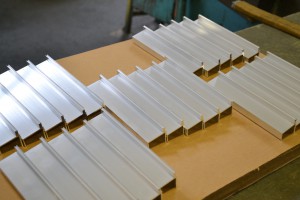by C. Villefrance Moeller, TalesOfLeading
The Mayor and the headmistress showed us around the school they were renovating. They told us how the reform influenced the size and layouts of the rooms. We were supposed to see how well they used our tax money. It was very interesting to hear about the intentions and plans for the school, but my eyes kept wandering around the rooms. The workers had not finished the work yet. Tools and materials were left on the floor and wires were sticking out of the wall. Suddenly something caught my eyes. It was a primitive board with a blueprint of the building. With a black pen someone had marked which walls were finished. This made me curious to understand how they used the board. Unfortunately, it was in the late afternoon and all the workers and their leaders had left, so I couldn’t talk to them. I imagined how the workers had been standing around the board talking about their work.
What do you see?
 I must say that it’s rather typical for me that what I find most interesting on a tour round a workplace is not what my host usually show me. I often find myself with my back turned to the group looking in the opposite direction. The host might want to show me the new fancy product or automated manufacturing. Well, yes It can be interesting to se what robots can do and how vision systems can sort out bad quality. However, I’m more interested in how the work is organized and carried out. I’m interested in how people interact with each other. I like visualizations like parts gathered in bundles of five easy to count. It obviously make work easier.
I must say that it’s rather typical for me that what I find most interesting on a tour round a workplace is not what my host usually show me. I often find myself with my back turned to the group looking in the opposite direction. The host might want to show me the new fancy product or automated manufacturing. Well, yes It can be interesting to se what robots can do and how vision systems can sort out bad quality. However, I’m more interested in how the work is organized and carried out. I’m interested in how people interact with each other. I like visualizations like parts gathered in bundles of five easy to count. It obviously make work easier.
A visualized status
Most Lean girls and guy’s will se a wall of red and green diagrams for the mind’s eye when talking about visualized status. It can be boards with a few diagrams placed at the workplace. Some visualize status on large screens with numbers so that everybody can see them. Some visualized status’ are clustered in large war-rooms where so many people gather at standing meetings that they have to ware microphones. I have also seen these war-rooms at the shop-floor surrounded by people and machines stamping, bending, assembling products. When I visit manufacturing sites managers usually point them out for me to show how transparent their control systems are. However, I’m not always sure, that the employees in the area really know how their work influence the numbers. When I ask I get the answers they are supposed to give, but what do they really do? How do they know they are doing the work at the right quality right now and not looking in the rear-mirror for the past week or month?
Ambiguity on the shop-floor
I can understand how important a management tool this is for managers. It legitimize a leaders power to control and set the work pace. Sometimes it sends an ambiguous message to the employees, when the leader puts safety first at the board and at the same time have the number of produced parts on the large screen. Each employee will then consider what objective hurts most not to achieve. It’s then up to the leaders behaviour to show what really maters. I’m sure these leaders do their best under the conditions they have. They are also following orders from their superiors who have “bought” a concept and implemented it by appointing project managers or change agents to do the dirty work. If a leader starts asking questions she risk being stigmatized as resisting change.
Questions for you
- Do you use visual methods in your area?
- Does it make balancing work load in your team more transparent?
- Are there any ambiguities in your area?